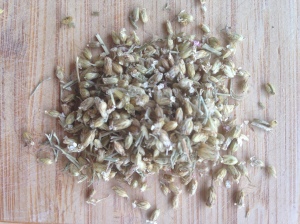Achillea millefolium Common name: Yarrow
Family: Asteraceae
Part used: Aerial
Constituents: Volatile oil (borneol, camphor, thujone, chamazulene, azulene, linalool, limonene, cineole, sesquiterpene lactones), tannins (condensed and hydrolyzable), flavonoids (apigenin, luteolin, rutin), alkaloids (achilletin, betonicine, stachydrine, trigonelline), acids (caffeic, salicylic, succinic), amino acids, nutrients (ascorbic acid, folic acid), cyanogenetic compounds, sugars, coumarins, furanocoumarins, bitter (achillein), stigma/sito/erythrosterin, alkamides
Actions: Anti-hemorrhagic, anti-inflammatory, anti-pyretic, antiseptic, astringent carminative, diaphoretic, hemostatic, hypotensive, peripheral vasodilator, bitter tonic, hepatic, choleretic, emmenagogue, diuretic, vulnerary, anti-rheumatic, antispasmodic

Medical uses: One of the best diaphoretic herbs and is a standard remedy for aiding the body to deal with fevers. A peripheral circulatory stimulant, it is utilized in any febrile condition, including acute, chronic and recovery phases and will increase the body’s sensitivity to adrenaline. It lowers blood pressure due to dilation of peripheral vessels. It stimulates digestion and tones the blood vessels, and is specific for thrombotic conditions with hypertension. As a urinary antiseptic it is indicated in infections such as cystitis. Achillea is both a relaxant and tonifying agent for the smooth muscle of the pelvic viscera. Used externally it will aid in the healing of wounds. It is astringent and used as a hemostatic in a variety of bleeding conditions associated with mucous membranes (wounds/ulcers)
- Cardiovascular Conditions: Varicose veins, elevated diastolic blood pressure.
- Gastrointestinal Conditions: Being predominately bitter, is used for atonic states of the stomach. The German Commission E lists indications as loss of appetite and dyspeptic ailments, such as mild, spastic discomforts of the gastrointestinal tract. Mills and Bone include the use of Achillea as a diaphoretic herb to control fever in gastrointestinal infections and viral hepatitis.
- Gynecological Conditions: Considered a universal regulator of female reproductive function. It achieves this effect through vitalizing the venous circulation to remove uterine and pelvic congestion. It is a uterine stimulant, and relieves delayed, painful menses and has a spasmolytic effect allaying dysmenorrhea. Is also used as a hemostatic in dysfunctional uterine bleeding. Will check excessive bleeding (eg. menorrhagia) if taken long-term and is used as a supportive herb for uterine myomas. As sitz bath Achillea can be used in the treatment of painful, cramp-like psychosomatic conditions in the lower part of the female pelvis.
- Respiratory System Conditions: Indicated as a diaphoretic in acute and chronic bronchitis.
Pharmacology:
- Thujone is present in low amounts, however in high doses is toxic to the nervous system and an abortifacient. Low doses are anti-fungal, anti-microbial, emmenagogue and immuno-stimulant.
- Volatile oils: Chamazulene is soothing, anti-allergic and anti-inflammatory. Borneol is anti-microbial. Cineole is antispasmodic, carminative and antiseptic. Caryophyllene is anti-allergic, anti-inflammatory and hepatic.
- Sesquiterpene lactones are anti-inflammatory, antimicrobial, cytotoxic and can cause contact dermatitis.
- Tannins are astringent and anti-hemorrhagic.
- Flavonoids are antispasmodic and anti-inflammatory.
- Alkaloids betonicine, stachydrine, trigonelline are anti-pyretic and hypotensive.
- Alkaloid achilletin reportedly stops bleeding in animals. It soothes the digestive system by relieving muscle spasms in the intestines, promotes the flow of digestive bile, fights bacterial invasion, and firms and tightens tissues.
- Furanocoumarins are anticoagulant.
- Achillein (a bitter glycoside) is a choleretic and digestive stimulant.
- Alkamides (also found in Echinacea) are anti-inflammatory.
- Three antitumor sesquiterpenoids, achimillic acids A, B and C, were isolated as methyl esters from and found to be active against mouse P-388 leukemia cells in-vivo.
Pharmacy: Infusion: 1-2 tsp/cup, infuse 15 min, TID or hourly in fevers. Tincture: (1:5, 25%), 2-4 ml TID. Dried herb: 2-4g, TID.
Contraindications: Avoid during the first trimester of pregnancy as it has a mild uterine stimulant effect. Long-term use (months) may lead to photosensitivity and that sensitive individuals may develop a rash. The essential oil is contraindicated in pregnancy due to its emmenogogue and abortifacient effects. Increases gut motility, thus may theoretically decrease absorption of drugs if taken simultaneously.
Toxicity: The volatile oil contains thujone which is a neurotoxic compound. Used with caution. High doses may cause headaches and photosensitivity.
Contraindications: Allergy to Asteraceae family, Pregnancy.
Interactions: None known.

Lininger et al, Healthnotes: Clinical Essentials, Herb Monographs. Prima Publishing, Rocklin, CA. 2001.
Mark Blumenthal et al (eds), Herbal Medicine: Expanded Commission E Monographs, American Botanical Council, Austin, Texas, 2000, pp.420-1
Y. Tozyo et al, “Novel Antitumor Sesquiterpenoids in Achillea millefolium,” Int J Clin Pharmacol Ther, Vol 35, Num 7, Jul 1997, pp. 296-301

Discussion
Comments are closed.